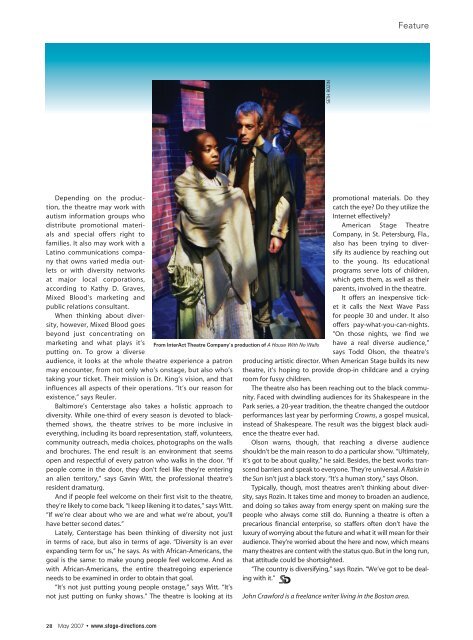May Issue - Stage Directions Magazine
May Issue - Stage Directions Magazine
May Issue - Stage Directions Magazine
Create successful ePaper yourself
Turn your PDF publications into a flip-book with our unique Google optimized e-Paper software.
Feature<br />
Seth Rozin<br />
Depending on the production,<br />
the theatre may work with<br />
autism information groups who<br />
distribute promotional materials<br />
and special offers right to<br />
families. It also may work with a<br />
Latino communications company<br />
that owns varied media outlets<br />
or with diversity networks<br />
at major local corporations,<br />
according to Kathy D. Graves,<br />
Mixed Blood’s marketing and<br />
public relations consultant.<br />
When thinking about diversity,<br />
however, Mixed Blood goes<br />
beyond just concentrating on<br />
marketing and what plays it’s<br />
putting on. To grow a diverse<br />
audience, it looks at the whole theatre experience a patron<br />
may encounter, from not only who’s onstage, but also who’s<br />
taking your ticket. Their mission is Dr. King’s vision, and that<br />
influences all aspects of their operations. “It’s our reason for<br />
existence,” says Reuler.<br />
Baltimore’s Centerstage also takes a holistic approach to<br />
diversity. While one-third of every season is devoted to blackthemed<br />
shows, the theatre strives to be more inclusive in<br />
everything, including its board representation, staff, volunteers,<br />
community outreach, media choices, photographs on the walls<br />
and brochures. The end result is an environment that seems<br />
open and respectful of every patron who walks in the door. “If<br />
people come in the door, they don’t feel like they’re entering<br />
an alien territory,” says Gavin Witt, the professional theatre’s<br />
resident dramaturg.<br />
And if people feel welcome on their first visit to the theatre,<br />
they’re likely to come back. “I keep likening it to dates,” says Witt.<br />
“If we’re clear about who we are and what we’re about, you’ll<br />
have better second dates.”<br />
Lately, Centerstage has been thinking of diversity not just<br />
in terms of race, but also in terms of age. “Diversity is an ever<br />
expanding term for us,” he says. As with African-Americans, the<br />
goal is the same: to make young people feel welcome. And as<br />
with African-Americans, the entire theatregoing experience<br />
needs to be examined in order to obtain that goal.<br />
“It’s not just putting young people onstage,” says Witt. “It’s<br />
not just putting on funky shows.” The theatre is looking at its<br />
From InterAct Theatre Company’s production of A House With No Walls<br />
promotional materials. Do they<br />
catch the eye? Do they utilize the<br />
Internet effectively?<br />
American <strong>Stage</strong> Theatre<br />
Company, in St. Petersburg, Fla.,<br />
also has been trying to diversify<br />
its audience by reaching out<br />
to the young. Its educational<br />
programs serve lots of children,<br />
which gets them, as well as their<br />
parents, involved in the theatre.<br />
It offers an inexpensive ticket<br />
it calls the Next Wave Pass<br />
for people 30 and under. It also<br />
offers pay-what-you-can-nights.<br />
“On those nights, we find we<br />
have a real diverse audience,”<br />
says Todd Olson, the theatre’s<br />
producing artistic director. When American <strong>Stage</strong> builds its new<br />
theatre, it’s hoping to provide drop-in childcare and a crying<br />
room for fussy children.<br />
The theatre also has been reaching out to the black community.<br />
Faced with dwindling audiences for its Shakespeare in the<br />
Park series, a 20-year tradition, the theatre changed the outdoor<br />
performances last year by performing Crowns, a gospel musical,<br />
instead of Shakespeare. The result was the biggest black audience<br />
the theatre ever had.<br />
Olson warns, though, that reaching a diverse audience<br />
shouldn’t be the main reason to do a particular show. “Ultimately,<br />
it’s got to be about quality,” he said. Besides, the best works transcend<br />
barriers and speak to everyone. They’re universal. A Raisin in<br />
the Sun isn’t just a black story. “It’s a human story,” says Olson.<br />
Typically, though, most theatres aren’t thinking about diversity,<br />
says Rozin. It takes time and money to broaden an audience,<br />
and doing so takes away from energy spent on making sure the<br />
people who always come still do. Running a theatre is often a<br />
precarious financial enterprise, so staffers often don’t have the<br />
luxury of worrying about the future and what it will mean for their<br />
audience. They’re worried about the here and now, which means<br />
many theatres are content with the status quo. But in the long run,<br />
that attitude could be shortsighted.<br />
“The country is diversifying,” says Rozin. “We’ve got to be dealing<br />
with it.”<br />
John Crawford is a freelance writer living in the Boston area.<br />
28 <strong>May</strong> 2007 • www.stage-directions.com

















